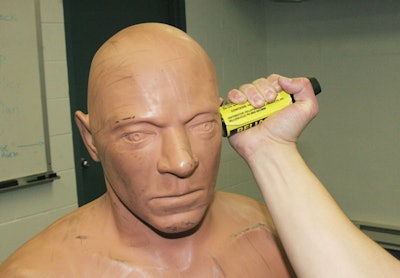 Photo: Tom Wetzel
Photo: Tom Wetzel
One of the concerns with basic law enforcement training in this country is that it doesn't always teach officers what to do when things go wrong.
Murphy's Law states that if something can go wrong, it will go wrong. And soldiers will tell you that "Murphy never sleeps" in combat. Things are always going wrong, and those things get people killed. The same is true for police officers on the streets of Anytown, USA.
You can't expect your equipment to always function exactly like you want it to. You have to be ready to react when things go wrong. So training for weapon malfunctions of handguns, electronic control devices (ECD), and OC canisters should be a common practice within police agencies.
Handgun malfunctions and how to clear them probably were included in your law enforcement training. You should be prepared to do these actions without much thought because, depending on the situation, you may not have much time to clear a jam and get back into the fight.
But what happens if that time is reduced even further and a suspect has closed in on you to a point where you do not have time to clear a jam, replace an ECD cartridge, or re-holster a canister of OC spray? Training to use your force option tools as impact weapons may help prepare you for such an encounter and could help stop or slow an assault against you.
Handgun Strikes
Your handgun is obviously not a primary impact weapon. You are not going to use it to subdue a suspect in substitute of a baton strike. That would be reckless. But if you are intending to use deadly force and your weapon malfunctions, you can end up in a position where your only option may be to strike an attacker with your gun.
Striking someone with a handgun is not an action to be taken lightly. It should only be done when you have no better alternative because doing so puts you at risk of losing your pistol to an assailant. It can also cause serious injury to the subject, especially if you strike him or her in the head. And it could discharge, if the jam clears with the impact.
A handgun strike is a desperate, last-ditch defensive measure, but nonetheless, it's one you should practice. If you haven't trained to perform this action, you won't be able to do it successfully when you need it.
You have to commit to this move. Awkwardness and tentativeness can result in disaster. You also have to be aware of weapon retention concerns before you make this strike. Dropping your gun or having it taken away are very real possibilities, and your trainer should discuss them with you.
The purpose of striking an assailant with your handgun is to stun or stop him or her. It's a delaying action intended to give you enough space between you and your attacker to clear your weapon malfunction or perform a reload and get back into the fight.
When teaching techniques and directing training drills using handguns (NOTE: For safety, use colored gun replicas such as a Blue Gun), your trainers should have you practice strikes from standing and ground positions. The best target area for these strikes is the head, which could disorient or knock out a suspect. As discussed before, head strikes can cause severe injury and even death, but remember you are already in a deadly force situation.
And the head is not the only effective target for a handgun strike. You can stun or stop an attacker with a strike to the solar plexus, groin, or throat. The appropriate target is dependent on your position relative to the attacker.
Emphasis should be placed on controlling the handgun with a solid grip and preventing the barrel from facing you when striking with a handgun. If that malfunction clears itself during the struggle, you don't want the muzzle covering you.
Strikes can be practiced in an open form and also against a heavy bag or training mannequins using replica guns such as Blue Guns. The drills should be conducted at a slow pace at first and then pick up speed as you get better with the technique's form. Some techniques to consider are the following:
- Punching with the Barrel—In a standing position practice straight punches with the barrel facing the subject. This strike can include a turning of the fist as this follows a typical punch configuration. After the standing position, move to the ground and practice upward and side strikes with the same technique.
- Punching with the Bottom of the Handle—Depending on the proximity of the assailant, a strike with the butt of the weapon may be effective. Practice directing the end of the handle forward as a strike. When doing so, the barrel will turn to the side or upward.
- Forward Snapping Strike—While holding the handle, direct a snapping forward strike using the barrel like a baton. This type of movement may allow for quick repetitive strikes. Upward or reverse snapping strikes can also be practiced.
ECD Strikes
ECDs, such as stun guns and TASERs, are primarily used in non-deadly force incidents in which you need to control a subject and take him or her into custody. Consequently, they are rarely used to strike subjects.
But use-of-force encounters can change instantly and go from control situations to deadly force situations. So it is imperative that you know how to use an ECD as an impact weapon when things go wrong. ECDs can fail when you need them most. And when that happens you may not have time to draw another weapon and stop an assault. So you may have to use an ECD as an impact weapon.
Strikes with an ECD are performed in a similar manner to those using a handgun. However, it must be emphasized that if deadly force is not warranted you should not strike someone in the head with an ECD. As with a handgun, a head strike with an ECD can cause serious injury and even death. So before you strike someone in the head with an ECD, make sure that such a use of force is warranted.
OC Canister Strikes
Like ECDs, OC spray is supposed to be used in situations that do not warrant deadly force. But there are situations where it becomes compromised. Some subjects can fight their way through its effects; you sometimes find yourself with an empty canister when you need to deploy more OC; and sometimes the canister fails to work.
So it's possible that at some time in your law enforcement career, you may find yourself facing an assaultive subject with an ineffective OC canister in your hand. If you can't transition to another weapon, your best option may be to punch the subject with the canister held in your fist.
This is essentially the old roll-of-quarters trick that hoodlums have used for decades. You can either punch normally with this combination or position the canister in your hand in such a way that it is sticking slightly out of your fist where the canister makes direct contact with the target area. These techniques are easy to execute, but you still want to practice them on a training mannequin or a heavy bag. (NOTE: Use training canisters for this training so that you do not run the risk of spraying OC in your training area.)
Flashlight Strikes
There was a time when officers routinely struck subjects with heavy D-cell battery patrol flashlights. Use of flashlights as impact weapons is now generally discouraged. A heavy flashlight can cause severe injury, especially if it is used to make a head strike. That's why many agencies have policies that prohibit the use of flashlights as impact weapons.
Still, there are times when you may have no other option but to hit a subject with a light. For example, it's not unusual for subjects to attack officers while they are holding flashlights at nighttime traffic stops.
That's why I believe agencies should not prohibit all flashlight strikes. Instead they should train their officers how to perform them properly and effectively with minimal chance of severe injury to the subject, i.e. pressure point control measures, unless severe force is justified.
You will probably not have to apply your use-of-force tools in uncharacteristic fashions. Usually they will work as intended. But being prepared to use your weapons as impact tools when they don't work and you have no other options can save your life.
Tom Wetzel is a northeast Ohio suburban police lieutenant, SWAT officer, trainer, and certified law enforcement executive.












